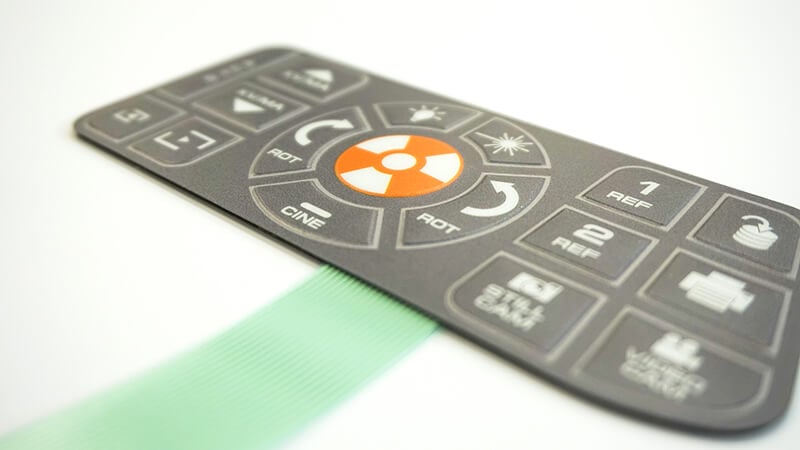Explore Various Kinds Of Membrane Switch Technologies for Your Needs
Explore Various Kinds Of Membrane Switch Technologies for Your Needs
Blog Article
Exactly How Membrane Layer Switches Add To the Sturdiness of Electronic Control Panels
Membrane layer switches play a vital role in enhancing the durability of electronic control panels, mostly via their multi-layered building which offers efficient protection versus ecological aspects such as wetness and dirt. The absence of relocating components substantially lowers the chance of mechanical failings, making membrane layer changes suitable for demanding applications.
Definition of Membrane Switches

Membrane switches are made to be thin and lightweight, making them ideal for applications where area is limited. They can be made in numerous shapes, sizes, and colors, providing versatility in layout that meets visual and useful requirements. Additionally, membrane layer buttons can incorporate numerous technologies, such as responsive comments and LED indicators, boosting customer experience.
Because of their building, membrane switches are often resistant to dirt, dampness, and basic wear, adding to their durability in requiring atmospheres. Their seamless style not just facilitates simple cleaning however likewise minimizes the threat of mechanical failure, making them a favored option for manufacturers looking for reliable customer interfaces in their electronic control board.
Security Versus Ecological Elements
The style of membrane layer switches naturally gives a degree of security versus numerous environmental elements, which is vital for preserving performance in challenging conditions - Membrane Switch. These buttons are generally created with layers of flexible materials that protect interior parts from dampness, dust, and contaminants. By encapsulating the circuitry, membrane layer changes minimize the threat of brief circuits and corrosion, which can substantially impair efficiency
In addition, making use of robust adhesives and sealers throughout production boosts their resistance to environmental obstacles. Membrane buttons can sustain direct exposure to chemicals and solvents, making them suitable for markets such as food processing and health care, where hygiene and cleanliness are critical. Their seamless surface style likewise protects against the buildup of dirt and germs, assisting in simpler cleaning and maintenance.
Temperature level changes are another ecological problem, and membrane buttons are crafted to operate successfully across a wide range of temperature levels (Membrane Switch). This adaptability makes certain that control board remain operational in various settings, from industrial atmospheres to consumer electronics
Effect On Individual Interaction
User communication browse around this site with electronic control board is dramatically affected by the design and capability of membrane switches. These switches give a tactile user interface that boosts the total individual experience, allowing for intuitive navigation and control. Their responsive nature makes certain that individuals get instant feedback upon activation, which is essential for tasks requiring accuracy and efficiency.
In addition, the smooth surface of membrane layer switches promotes very easy cleansing and maintenance, promoting user confidence in the integrity of the interface. This tidiness is particularly vital in settings where hygiene is critical, such as medical or food processing settings. Additionally, the portable and lightweight design of membrane changes adds to the aesthetic appeal of control panels, motivating customer interaction via a modern-day and sleek appearance.
In addition, the assimilation of visual elements, such as published symbols and backlighting, helps users swiftly recognize features, lowering the learning contour connected with brand-new equipment. As a result, individuals can run devices better, causing boosted performance and complete satisfaction. In summary, membrane layer buttons play a critical duty in boosting customer communication by combining capability, visual appeals, and convenience of use, ultimately resulting in improved Membrane Switch functional effectiveness.
Layout Versatility and Modification
Layout flexibility and personalization are important facets of membrane buttons, allowing producers to tailor digital control panels to details applications and user needs. This versatility permits the integration of different layout aspects, such as shades, graphics, and textures, which can improve the visual allure and user interaction of the control panel.
Membrane layer buttons can be personalized in shapes and size, fitting a wide variety of devices and applications, from commercial machinery to consumer electronics. This versatility ensures that makers can develop instinctive interfaces that straighten with user assumptions and functional needs. Additionally, the capability to incorporate one-of-a-kind attributes such as backlighting or responsive feedback better enhances functionality, enabling a more interactive experience.
Moreover, the production procedure for membrane layer switches over sustains the fast prototyping of styles, allowing producers to repeat and fine-tune their concepts swiftly. This ability not only accelerates the growth timeline but additionally makes sure that the end product fulfills specific functional and aesthetic requirements.

Cost-Effectiveness and Long Life
Cost-effectiveness and longevity are substantial advantages of membrane switches, making them an appealing choice for suppliers and end-users alike. These buttons are generally less costly to create than traditional mechanical switches, largely because of their streamlined manufacturing procedures and the minimized variety of parts called for. This price advantage expands not just to preliminary manufacturing however also to lasting operational costs, as membrane layer switches often need much less upkeep and have a reduced failing price.
Furthermore, the long life of membrane switches adds to their overall value. Created from long lasting materials, they are resistant to ecological factors such as dampness, dust, and chemicals, which can result in premature wear in other button kinds. The absence of moving parts lessens mechanical failure, permitting membrane changes to maintain performance over expanded durations.
This resilience is especially useful in applications requiring constant performance under demanding problems, such as medical gadgets and commercial equipment. Inevitably, the combination of cost-effectiveness and longevity makes membrane changes an economically sensible selection for manufacturers, offering reliable remedies that stand up to the test of time while optimizing budgetary considerations.
Verdict
In final thought, membrane layer switches substantially enhance the sturdiness of electronic control our website panels with their robust construction and safety attributes - Membrane Switch. In general, membrane switches stand for a reliable and affordable choice for enhancing the longevity and performance of digital control systems.
Report this page